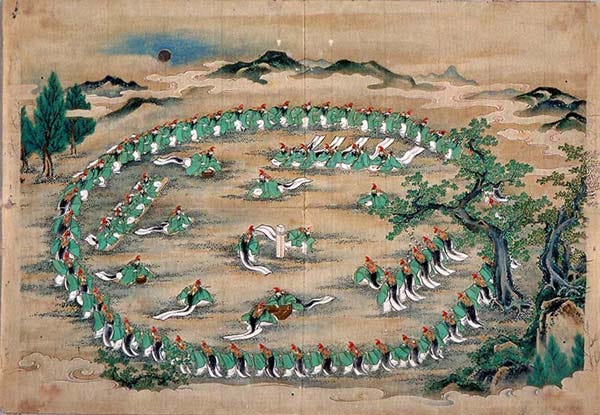Hirata Atsutane and the Birth of Spiritual Shinto
Kokugaku, the Spirit World, and Hirata Atsutane’s Vision for Shinto
Many people find themselves captivated by the spiritual dimension of Shinto, yet its history remains shrouded in mystery. How did Shinto, traditionally sealed within its own doctrines, finally merge with deeper spirituality? The decisive turning point was initiated by Hirata Atsutane (1776-1843), a Kokugaku (National Learning) scholar and founder of Restoration Shinto (Fukko Shinto).
While pursuing Kokugaku, Hirata developed a strong interest in the afterlife, opening a unique path he termed “spirit-world studies” (霊界研究). Among the works that later became essential reading for spiritual researchers were his Senkyō Ibun and Katsugorō Saisei Kiken.
Senkyō Ibun (仙境異聞): Inspired by rumors of a boy allegedly abducted by an Immortal Sage who reportedly wielded prophecy and superhuman abilities that astonished the people of Edo. Hirata personally investigated these stories and compiled his findings into this work.
Katsugorō Saisei Kiken (勝五郎再生記聞): Documents Hirata’s study of a child who claimed memories of a previous life.
Hirata also conducted his own investigations into supernatural phenomena, yokai, spirit possession, mysterious scripts, and ancient documents, publishing his findings one after another—captivating people’s curiosity in the process.
Moreover, Hirata himself mastered traditional Shinto techniques, entering altered states to explore the spirit world multiple times. Though he never met the renowned Kokugaku scholar Motoori Norinaga (1730-1801) in person, Hirata claimed that after Norinaga’s death, he traveled to the spirit realm to converse with him, ultimately receiving Norinaga’s permission to become his disciple.
Crucially, Hirata’s unique worldview had a profound impact on his conception of Shinto. Thanks to his influence, Shinto’s spiritual aspects came to the fore for the first time, forming the foundation for the spiritual movement that would unfold in the years ahead. Without recognizing Hirata’s contribution, one cannot fully grasp why, over the ensuing two centuries, Shinto has come to be widely regarded as profoundly spiritual.
In essence, Shinto spirituality was established for the first time by Hirata Atsutane. Why was he able to achieve this? One likely reason is that he did not specialize in Kokugaku or Shinto from the beginning. Born to parents who adhered to Confucian teachings, Hirata spent his first 20 years—before fleeing to Edo—living a life largely disconnected from any of these fields.
Even after arriving in Edo, he studied Western (Dutch) learning (rangaku). At the age of 28, a chance event radically altered his course: his wife happened to bring home a work by Motoori Norinaga, which she gave him to read. Building on his Confucian background, along with rangaku, Kokugaku, and Shinto, Hirata soon became one of the era’s leading intellectuals.
This perspective and network undermined the existing Shinto establishment. The two major sects recognized by the shogunate—Yoshida and Shirakawa—found themselves unable to adapt to the new era and quickly lost influence. Lacking the means to carry on without Hirata’s “heretical” scholarship, with its emphasis on spirituality, they sought out his assistance. Under his leadership, the two factions merged, giving rise to Restoration Shinto, also called Hirata Shinto. In practical terms, this is the source of modern Shinto.
The largely unspoken legacy of Hirata is that he toppled the rigid Shinto system—heavily codified during the Edo period—and ignited people’s curiosity about unseen realms. By fusing that curiosity with Kokugaku-based Shinto, he opened the way for an entirely new religious movement to flourish. Recognizing this is key to understanding the diverse developments in Shinto that began in the late Edo period and continued into the modern era.



